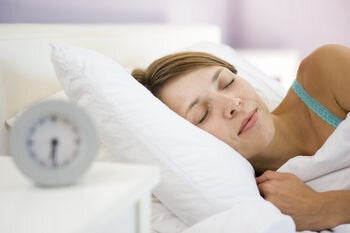
Here, at HuffPost Living, we have an obsession with sleep. How much should we be getting? Is there a difference between the genders? Why are so many people sleep-deprived? How can we treat sleep disorders? And the list goes on...
That's why it was so exciting at TEDMED 2009 to hear Philip Low talk about his groundbreaking sleep research. Low is the founder, chairman & CEO of Neurovigil, Inc, a wireless diagnostics company (they've developed the iBrain, an iPod for your brain). Low is also an adjunct Professor at Stanford School of Medicine and did his PhD at the Salk Institute, Francis Crick's (the father of DNA) lab.
After his stimulating talk at TEDMED, I sat down with Low to talk about his sleep research more in depth. Low told me that he saw a problem to be solved. The problem was that in order to assess a person's sleep patterns, electrodes had to be put all over the patient's head and body, making it very difficult to, well, sleep! It was widely believed that sleep could not be measured using a single sensor, but Low was set on showing it could.
"I felt that sleep was under appreciated," Low said. "It turns out we sleep one third of our lives, but most of the funding goes to exploring vision, memory, and critical processing--all wake states." Additionally, he said, the brain changes more while asleep than when in a wake state.
Low explained that it was hard for him to believe that sleep was just a rest state because when you look at the brain, it appears that it goes through fundamental changes during sleep, more than just upkeep. "I wanted to know what it was," he said.
Research at a laboratory at the University of Chicago discovered that during sleep, birds rehearse their song. This fascinated Low, who was spurred to invent a new way of recording brainwaves and analyzing the data. Three years later he emerged with the SPEARS Algorithm, a single channel EEG, which creates a map of brain activity showing the different brain states you have during sleep. Through SPEARS, Low has revealed a new sleep state, which shows that REM sleep is comprised of two stages.
Now, Low is using sleep to collect bio-markers of neuropathologies like Alzheimer's (sleep disorders are the #1 reason Alzheimer's patients are hospitalized), Parkinson's, and schizophrenia (schizophrenics don't experience stage two sleep). He also told me that people with clinical depression have too much REM sleep and by depriving them of REM sleep, they feel relieved of their depression.
So where do we go from here? Low says using his technology people could have access to their brain through their cell phones! "If we can have millions of people have access to their brainwaves through cell phones, then we can see a real bio-marker for Alzheimer's, schizophrenia, and Parkinson's," Low said.
Crazy fact: 70 million Americans have a sleep disorder and only 4 million get sleep tests each year. By using Low's technology you don't have to be hooked up to machines and sleep in a lab, which makes the possibility of diagnosing issues through sleep more of a reality than ever.
Full Coverage Of TEDMED 2009: